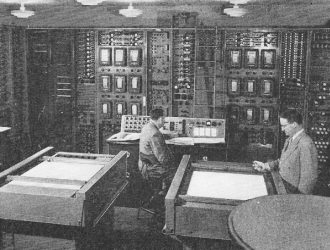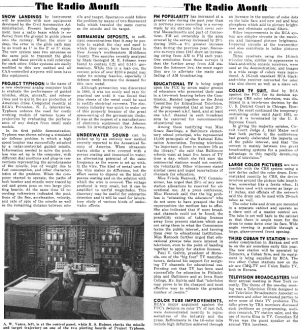|
February 1951 Radio-Electronics
 [Table of Contents] [Table of Contents]
Wax nostalgic about and learn from the history of early electronics.
See articles from Radio-Electronics,
published 1930-1988. All copyrights hereby acknowledged.
|
"The Radio Month" was a
regular industry news briefs feature of Radio-Electronics magazine." In
1951 when this issue was published, nearly all computers were of the analog variety.
The monstrous (in size)
UNIVAC
digital computer was not commissioned into operation until March of the same year
(1951). Leading the report this month was
Project Typhoon, an analog computer developed by RCA. It sported more than 4,000
vacuum electron tubes with 100 user-adjusted dials and 6,000 plug-in connectors
or use in programming. According to the book
The Analogue Alternative, "Project Typhoon was justifiably described as a 'veritable
fountain head of improved computing elements.' One of the most important developments
to come out of Project Typhoon as the invention of the chopper-stabilized, or drift-free, DC operational amplifier by
E[dwin].A. Goldberg." In other news, new deposits of germanium had been
discovered in New Jersey, of all places. Silicon had not yet become the dominant
semiconductor material. Also, FM radio was becoming a very popular form of
commercial broadcast listening; many people believed it would eventually be the
mode of choice (over AM).
The Radio Month

A. W. Vance, left, is at the control panel, while R. S. Holmes
checks the missile and target trajectory on one of the two plotting boards of Project
Typhoon analog electronic computer.
Project Typhoon is the name of a new electronic analog computer
built to evaluate the performance of guided missiles, ships, aircraft, and submarines
and to aid in the air protection of American cities. Completed recently at RCA's
Princeton, N. J., laboratories, Typhoon reduces the need for costly working models
of various types of projectiles by evaluating the performance of any design from
small scale models.
In its first public demonstration, Typhoon was shown solving a simulated air
defense problem in which a high speed bomber was successfully attacked by a radar-controlled
guided missile. Information needed to solve the problem was set up in the computer,
with different dial positions and plug-in connections representing the aerodynamics
of the missile, loss of weight due to fuel consumption, and other characteristics
of the problem. When the computer started to operate, the paths of both bomber and
missile were traced by red and green pens on two large plotting boards. At the same
time 12 recording voltmeters indicated the positions of the fins, acceleration,
velocity, and rate of spin of the missile as well as the remaining distance between
missile and target. Spectators could follow the problem by means of two fluorescent
balls which traveled the same course as the missile and its target.
 Germanium Deposits, in sufficient
concentrations that it may be possible to exploit the clay and sand in which they
occur, have been found in New Jersey's northeastern Middlesex County. Two samples
recently analyzed by State Geologist M. E. Johnson were found to contain 0.21 and
0.14% germanium. While this is a lean ore, the current price of over $230 a pound
may make its mining feasible, especially if defense needs increase the demand for
this rare metal. Germanium Deposits, in sufficient
concentrations that it may be possible to exploit the clay and sand in which they
occur, have been found in New Jersey's northeastern Middlesex County. Two samples
recently analyzed by State Geologist M. E. Johnson were found to contain 0.21 and
0.14% germanium. While this is a lean ore, the current price of over $230 a pound
may make its mining feasible, especially if defense needs increase the demand for
this rare metal.
Although germanium was discovered in 1886, it was too costly and rare for practical
use until it was found that thin sheets of the metal could be used to rectify electrical
currents. The electronics industry was quick to make use of this property because
of the great space-saving of the germanium diodes. It was at the request of a manufacturer
of electronic equipment that Johnson made his investigations in New Jersey.
FM Popularity has increased at a greater rate during the past
year than in previous years according to a survey made by 'six stations which cover
central Massachusetts and part of Connecticut. FM set ownership in the area covered
by the survey increased by 29% during 1950 - a 9% greater increase than during the
previous year. Successive surveys since 1947 show an increasing swing from AM to
FM each year. One conclusion from these surveys is that the further away from AM
stations the listeners live, the more eager they are to alleviate the static and
fading of AM broadcasting.
Posted February 14, 2021
|











